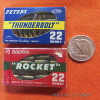.38 Special
Member
- Joined
- Sep 15, 2006
- Messages
- 7,379
As for leading and each consecutive bullet sweeping away the previous lead/fouling/copper...hogwash.
The actual argument, I believe, is that good quality .22 in a decent gun does not generally lead, and that it is the wax deposits in the bore which remain essentially in balance as the gun is used. Further, the idea is that removing the wax in the bore can result in a loss of accuracy, which only returns once the gun has been fired enough to restore the stable (ie. waxy) bore condition.
Last edited:




